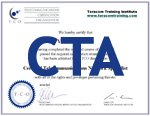$119
In this course, you’ll build a solid understanding of the fundamentals of the Public Switched Telephone Network (PSTN): customer premise and Central Office, loops, trunks, remotes, circuit switching and how a telephone call is connected end-to-end. We’ll cover LECs and IXCs, and Plain Ordinary Telephone Service and how it's implemented with sound, analogs, the voiceband, twisted pair, DTMF, loops, trunks and SS7 ISUP signaling.
Then, we will understand how this voice is carried in IP packets: Voice over IP (VoIP), and what will happen next: the Internet and the telephone network will become the same thing, and basic telecom service is called Broadband IP Dial Tone.
In the meantime, there are hundreds of millions of POTS lines still in service, still being maintained and still generating revenue for carriers. This will not disappear overnight, but will continue to be supported for many years to come, until the last POTS line is disconnected.
Broadband Internet service is provided using DSL modems over the wires put in place for POTS.
Even if we were to move to an all-Voice-over-IP network, at least the last foot will still be analog: at residences, a cable modem or fiber terminal performs the functions of a POTS line card: power, dial tones, ringing and analog signals to regular phones via the telephone wires inside the house.
At a business, the analog-digital conversion might happen inside a VoIP telephone plugged onto the LAN - but the signals on the curly cord attached to the handset are still analog.
Many VoIP systems digitize voice at 64 kb/s, a bit rate that is directly related to the voiceband defined for analog POTS. Legacy SONET and SDH fiber-optic transmission infrastructure are organized into 64 kb/s channels.
There is a huge inertia of regulations, tariffs, accounting and money involved in the interconnect between local exchange carriers (the “last mile”), and inter-exchange carriers, (the “long distance”), that is based on Tandem Access Trunks, channelized PSTN circuit-switched technology.
Understanding channels and circuit-switching is still necessary to know how a phone call from a cellphone on a wireless network connects to a phone plugged into a competitor’s cable modem in another city.
The structure, components and operations described in this course were built worldwide, in every country on earth, during the period 1970 - 2000. Though circuit-switching has been eclipsed by IP packet switching, the installed base continues to generate revenue. Besides, to this day, a PSTN network address (your ten-digit phone number) is required to be able to receive a phone call from anyone! Lesson 10 explains how that will change.
Course Lessons
1. Introduction
2. History of Telecommunications (USA and Canada)
3. The Public Switched Telephone Network (PSTN)
4. Analog Circuits and Sound
5. The Voiceband
6. Plain Ordinary Telephone Service (POTS)
7. Signaling: Pulse Dialing and Dual Tone Multiple Frequency (DTMF)
8. Signaling System 7 (SS7)
9. Voice in IP Packets
10. IP Dial Tone
Based on Teracom’s famous Course 101, tuned and refined over the course of 20 years of instructor-led training, we’ll cut through the jargon to demystify telephony and the telephone system, explaining the jargon and buzzwords, the underlying ideas, and how it all works together… in plain English.
Featuring many photos of actual equipment both inside a Central Office and in the outside plant, this multimedia course is an excellent way to get up to speed on traditional telephony.
This course is the first course in the CTNS Certification Package. Purchase this item to get the individual course.
Course page with full description
The Unlimited Plan gives you unlimited repeats, with no expiration and no monthly fees. One-time payment. Take as long as you like. Jump in and out of lessons, refresh your knowledge in the future.
A course completion certificate is awarded upon passing the course exam.
Study Guide: Telecom 101 textbook. Available in print and eBook.
Course Outline
1. Introduction
Course overview
2. History of Telecommunications (USA and Canada)
Local phone companies, long distance; Bell System, breakup, LECs and IXCs; Canada
3. The Public Switched Telephone Network (PSTN)
Loops and trunks, CO, customer premise, circuit-switching, outside plant, loop length, remotes
4. Analog Circuits and Sound
What analog means, microphones, speakers, copper wires and electricity, sound: trees falling in the forest
5. The Voiceband
Reproducing thoughts vs. reproducing sound, frequency range, filters, limitations
6. Plain Ordinary Telephone Service (POTS)
Twisted pair, dial tone, ringing, supervision, lightning protection
7. Signaling: Pulse Dialing and Dual Tone Multiple Frequency (DTMF)
Dial-up, make-or-break signaling, touch-tone, DTMF, in-band signaling
8. Signaling System 7 (SS7) Control system for the PSTN, SCPs and SSPs, examples of sophisticated call routing
9. Voice in IP Packets
How Voice over IP (VoIP) moves a phone call end-to-end
10. IP Dial Tone
The Internet and the PSTN will be the same thing in the not-too-distant future. Basic telecom service will be not POTS but rather Broadband IP Dial Tone.
11. Multiple Choice Exam
Teracom is the leader in telecommunications training. In business since 1992, we supply this training to the US government under our GSA schedule contract, which means pre-approved quality and pricing. We're so confident of the quality of this training, it comes with a 30-day money-back guarantee.
